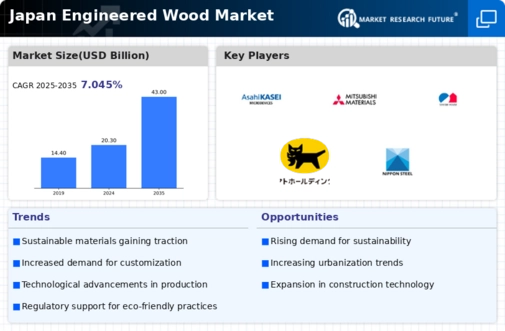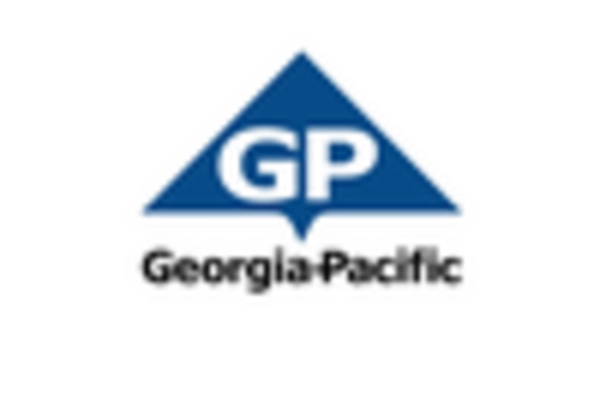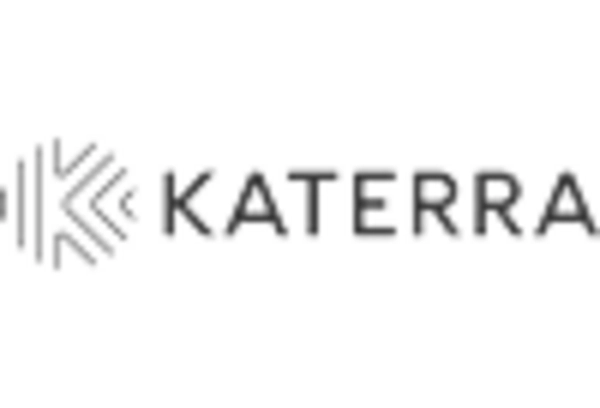Shifts in Consumer Preferences
Consumer preferences in Japan are evolving, with a growing inclination towards stylish and functional building materials. The engineered wood market is responding to this shift by offering a variety of aesthetically pleasing and versatile products. As homeowners and architects seek unique design elements, engineered wood provides an attractive alternative to traditional materials. In 2025, it is projected that the demand for engineered wood products will increase by 10%, driven by trends in interior design and sustainable living. This shift not only enhances the market's growth potential but also encourages innovation in product offerings, ensuring that the engineered wood market remains competitive and relevant.
Urbanization and Housing Demand
Japan's rapid urbanization significantly impacts the engineered wood market. As urban populations grow, the demand for housing and commercial spaces increases, leading to a surge in construction activities. The engineered wood market is poised to capitalize on this trend, as engineered wood products offer lightweight, durable, and cost-effective solutions for modern construction. In 2025, the housing sector is expected to contribute approximately $1.5 billion to the engineered wood market, driven by the need for efficient building materials. Additionally, urban planners are increasingly favoring engineered wood for its aesthetic appeal and structural advantages, further solidifying its role in the evolving landscape of urban development.
Government Regulations and Incentives
The engineered wood market in Japan is influenced by government regulations and incentives aimed at promoting sustainable building practices. Recent policies encourage the use of engineered wood products in construction projects, providing financial incentives for builders who choose eco-friendly materials. This regulatory environment fosters growth within the engineered wood market, as it aligns with national goals for reducing greenhouse gas emissions. In 2025, it is anticipated that government initiatives will lead to a 15% increase in the adoption of engineered wood in residential and commercial buildings. Such measures not only enhance the market's appeal but also contribute to the overall sustainability of the construction sector.
Technological Innovations in Production
Technological advancements in the production of engineered wood are reshaping the market landscape in Japan. Innovations such as improved manufacturing processes and enhanced material properties are driving efficiency and product quality. The engineered wood market benefits from these developments, as they enable manufacturers to produce high-performance products that meet diverse consumer needs. In 2025, it is estimated that technological innovations will account for a 20% increase in production capacity, allowing for greater market penetration. Furthermore, these advancements facilitate the creation of customized engineered wood solutions, appealing to a broader range of applications in construction and design.
Rising Demand for Eco-Friendly Materials
The engineered wood market in Japan experiences a notable increase in demand for eco-friendly materials. This trend is driven by heightened awareness of environmental issues and a shift towards sustainable construction practices. As consumers and builders prioritize green building certifications, the engineered wood market is likely to benefit. In 2025, the market for engineered wood is projected to reach approximately $2 billion, reflecting a growth rate of around 8% annually. This demand is further fueled by government initiatives promoting sustainable forestry and the use of renewable resources, which align with Japan's commitment to reducing carbon emissions. Consequently, the engineered wood market is positioned to thrive as it meets the evolving preferences of environmentally conscious consumers.

















Leave a Comment